Short-wave Radiation
Emitted from the Sun, it drives the Earth’s climate system.
Short-wave Radiation
Transmission, absorption and scattering (diffuse reflection) of solar radiation in the atmosphere causes a variety of optical effects.

Learning Objectives
- Describe the characteristics of the solar radiation reaching our planet.
- Explain what happens to the solar radiation as it passes through the atmosphere
- Understand the effects of slope on radiation receipt.
- Know the difference between direct and diffuse short-wave radiation.
Planck’s law
- Dependence of \(E\) and \(\lambda\) on T

Stefan-Boltzman law
- Integral of Plank’s Law

Wein’s law
- Maximum of Plank’s Law

Solar constant \(I_0\)
The radiant flux density (irradiance) at the top of the atmosphere normal to the solar beam an at Earth’s mean distance from Sun.
- Present observations suggest \(I_0 \approx 1361 W m{-2}\)
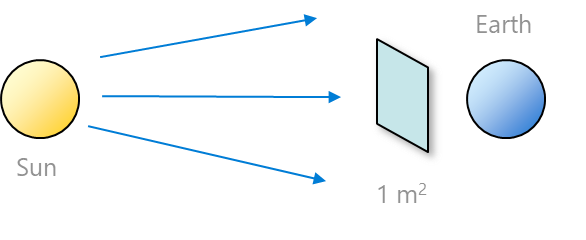

Average radiation on Earth
The solar constant is a “theoretical maximum”
True at equator at solar noon
Actual value is lower everywhere else

Attenuation of solar radiation (iClicker)
On its path from the top of the atmosphere to the ground, solar radiation is reduced. Why?
- A - Reflected back to space by clouds
- B - Scattered by aerosols and droplets
- C - Absorbed by certain gases, droplets and aerosols
- D - All of the above
Reflection
Clouds reflect 40 to 80% of the short-wave radiation incident upon them, the average is 55%.
- We call this the cloud albedo (\(\alpha\)), hence the ratio of the amount of solar (short-wave) radiation reflected by a body to the amount incident upon it.

Absorption in the atmosphere
The most significant absorbing substances are:
- H2O (vapor), CO2, O2, and O3
- The atmosphere is quite transparent (\(\tau \approx 1\)) near \(\lambda_{max}\) = 0.48 \(\mu m\)
- Intensity of solar radiation is greatest here
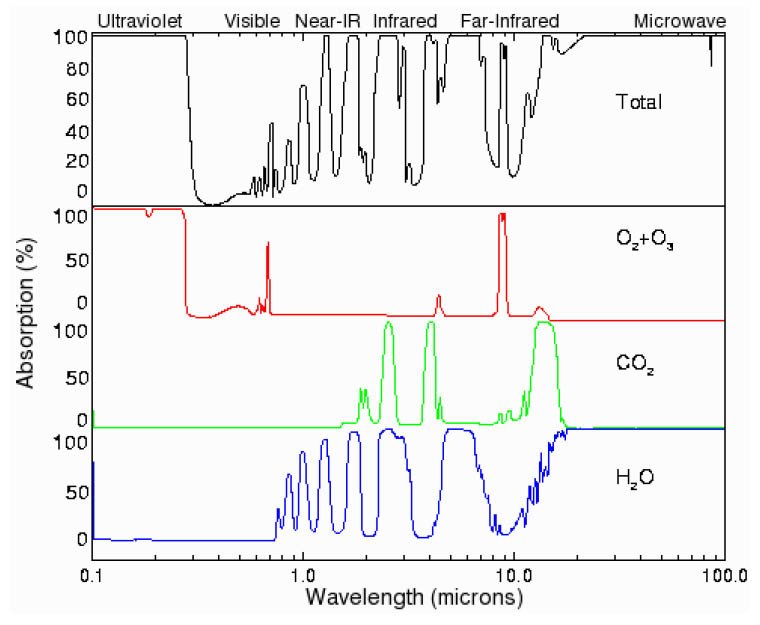
What does this Mean?
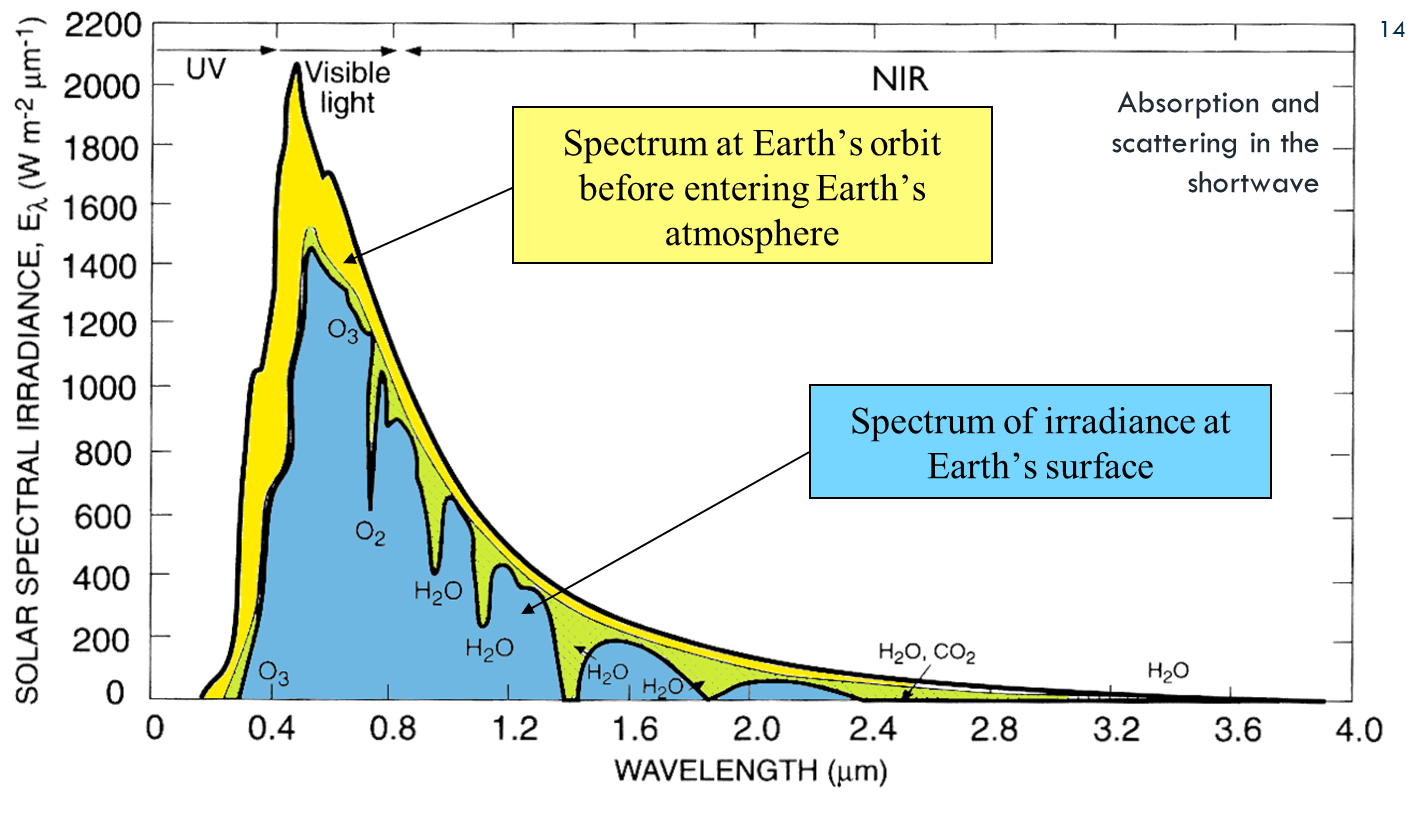
Optical Effects



Scattering
Scattering (diffuse reflection) is when incident light is diffused in all directions by the small molecules.
- Reduces solar radiation reaching the ground
- Diffuse the beam so that it arrives from all parts of the sky hemisphere.

Scattering
- Rayleigh: caused by gas molecules. Tends to scatter in all directions with a preference for shorter wavelengths
- Mie: associated with larger solid or liquid particles. Scatters wavelength equally and mostly in a forward direction.

Scattering by particle size
Transmission
- Typical fractions of the solar getting through to the ground are:
- “Clean” atmosphere \(\tau\) = 0.65-0.75
- “Dirty” atmosphere \(\tau\) = 0.45-0.55
- In Vancouver, a typical value is \(\tau\) = 0.70
Transmission Windows
Most visible radiation is transmitted
Second window lets thermal radiation escape
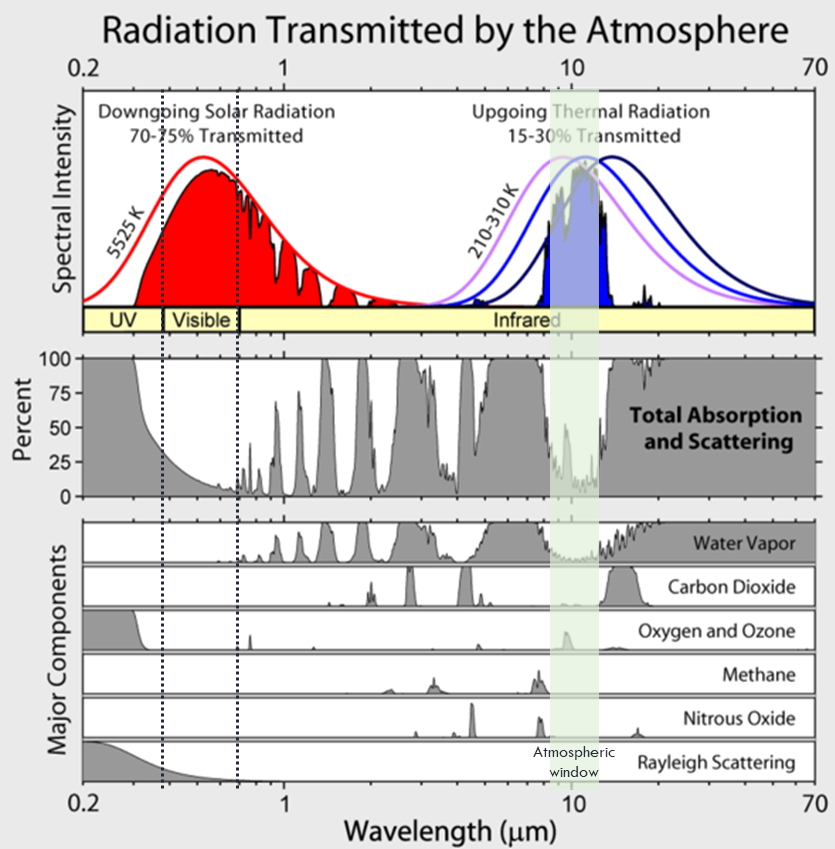
Transmission (iClicker)

Smokey Skies Reduce Transmission
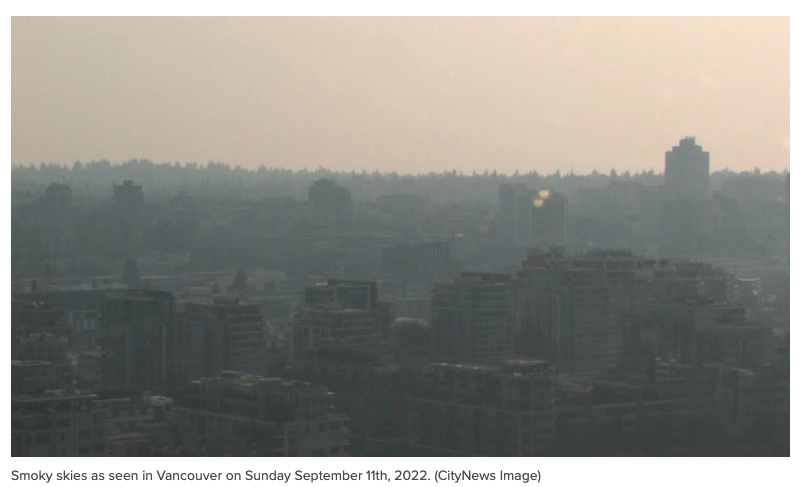
Cosine law of illumination
Describes how incident radiant flux density (irradiance) of a beam decreases as the beam’s angle varies from overhead.
- The same energy is spread over a larger surface area when a beam is tilted relative to the surface
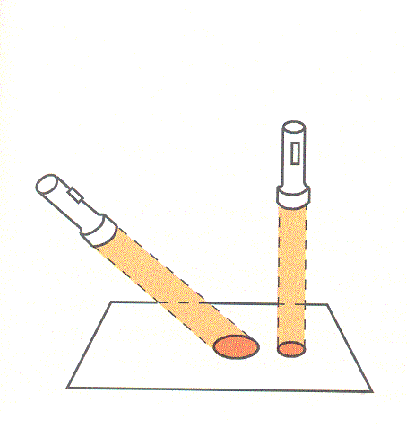
Cosine law of illumination
Flux density on a surface (\(R_s\)) is proportional to the flux density perpendicular to a beam (\(R_p\)) and the zenith (\(\theta\)).
- For a flat land surface at solar noon
\[ \theta = Latitude - Solar\:Declination \qquad(1)\]
- Solar Declination ranges from:
- +23.5 (summer solstice)
- 0 (equinoxes)
- -23.5 (winter solstice)
\[ R_s = R_p cos(\theta) \qquad(2)\]
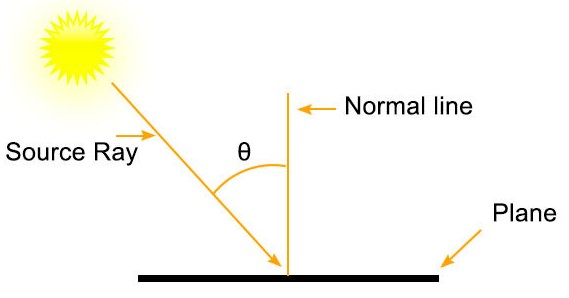
Cosine law of illumination
Radiation is distributed according to latitude and solar declination.
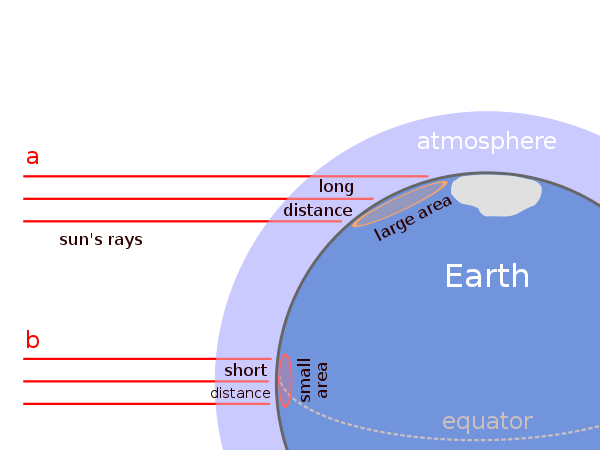
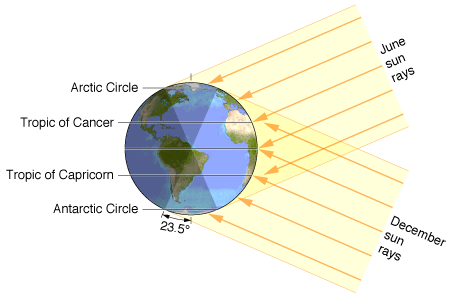
Cosine law of illumination (iClicker)
Compare the the flux density of a beam of sunlight at solar noon on the autumnal equinox at the equator and at the Arctic Circle (66 \(^{\circ}\) North latitude).
Note:
- \(R_s = R_p cos(\theta)\)
- At the equator, the sun is directly overhead: \(\theta = 0\)
- At 66 \(^{\circ}\) N latitude: \(\theta = 66\)
Irradiance at 66 \(^{\circ}\) N would be:
- A \(\approx\) 66% that at the equator
- B \(\approx\) 40% that at the equator
- C \(\approx\) 33% that at the equator
Irradiance
Shortwave irradiance (\(SW\downarrow\)) is the integration of all radiative fluxes coming from the upper hemisphere
- Per unit area
- Hence a radiative flux density in W m-2
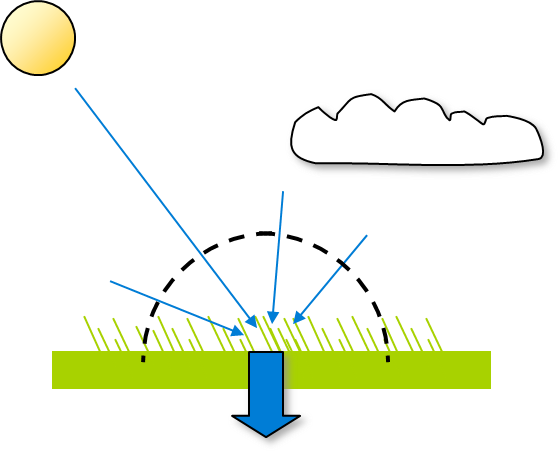
Direct vs. Diffuse Irradiance
Two types of solar radiation arrive at the Earth’s surface:
- Direct (s): comes directly in parallel rays from Sun.
- Diffuse (d): after scattering and reflection by the Earth’s atmosphere.

Total Irradiance
\[ SW\downarrow = SW\downarrow_S + SW\downarrow_D \qquad(3)\]
Note the differing label convention in this figure. Some sources will use “K” for shortwave radiation. I don’t like that because its too similar to “Kelvin”, so I prefer to use “SW”.

Direct and diffuse radiation - example
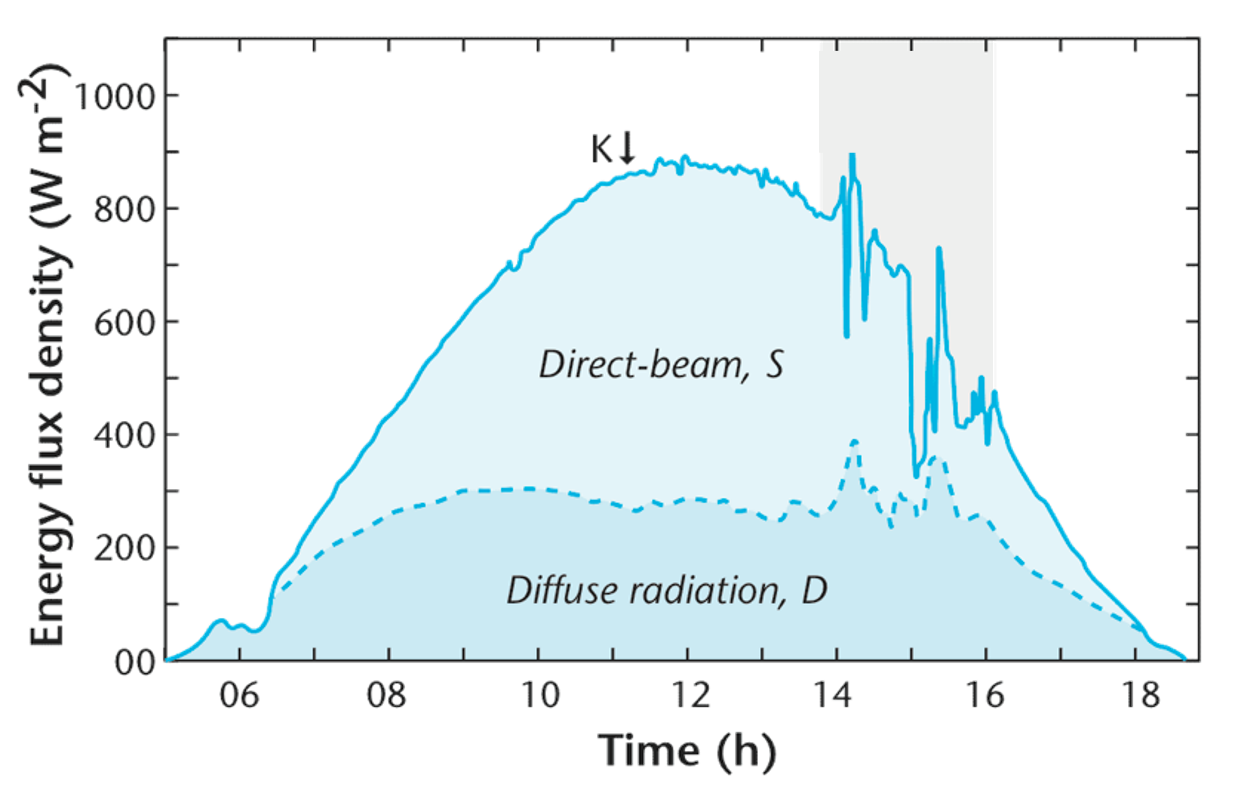
Direct and diffuse radiation - example
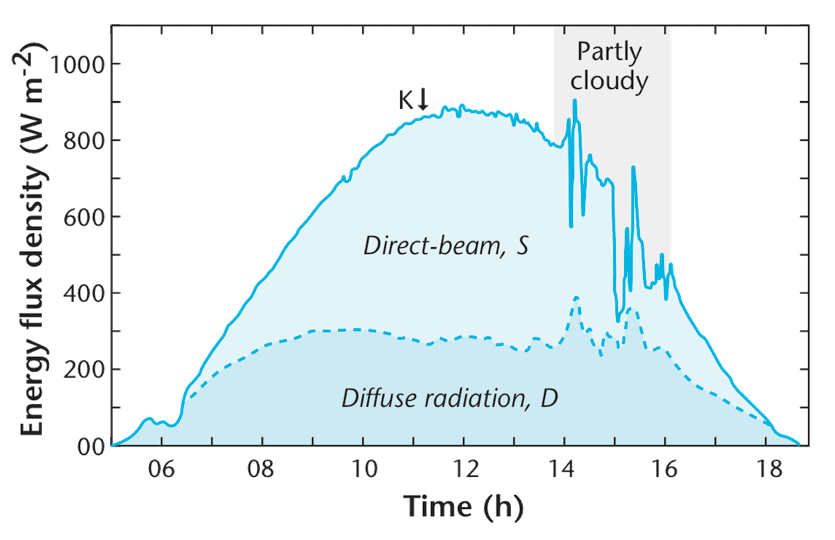
Graph interpretation summary
- The diffuse fraction is greater in the early morning and late evening (greater path length).
- The diffuse fraction increases with cloud cover
- Variability with scattered clouds
- ie. “Partly cloudy”
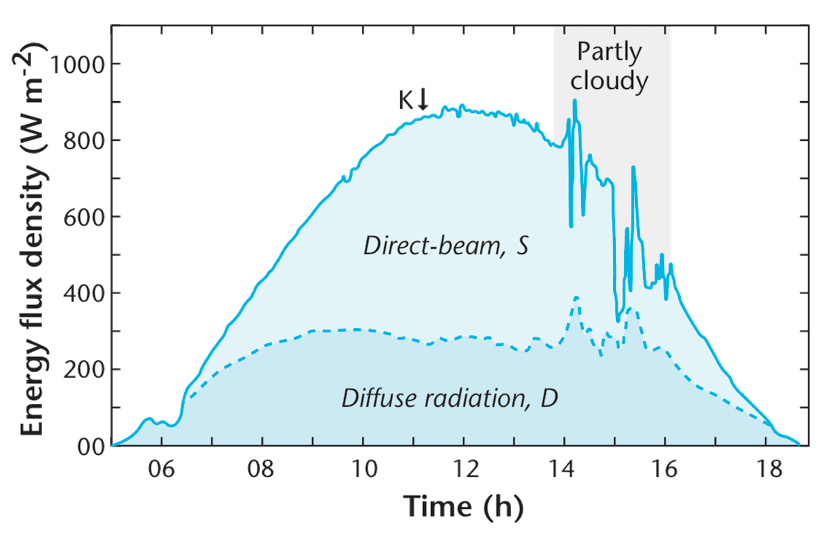
Pyranometer
Solar irradiance \(SW\downarrow = SW\downarrow_S + SW\downarrow_D\) is measured by a pyranometer.
- Glass domes transmit \(SW\)
- Prevent conduction / convection
- A thermopile measures the temperature rise of the absorbing black surface

Measuring Diffuse Radiation
The shade ring follows the solar path and eliminates direct radiation.
- Only D is measured by the pyranometer
- Paired with a non-shaded pyranometer, we can separate S and D
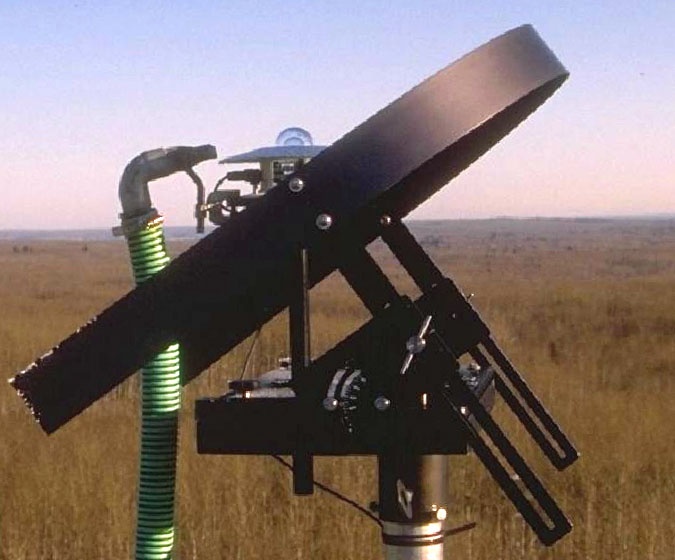
Take home points
- Short-wave radiation = solar radiation.
- What is the meaning of the solar constant I0?
- Solar radiation is reflected, scattered, and absorbed by certain gas molecules, droplets and particles in the atmosphere.
- The magnitude of the short-wave irradiance at the ground is mainly determined by the angle of the beam
- Cosine law of illumination
- Distinguish between direct and diffuse \(SW\) irradiance.